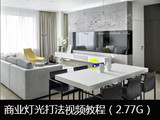【國外經典】Making Of starbucks coffee by Reinaldo Handaya
一天一篇的賞析又來了,今天這篇教程的作者也是前兩天翻譯的那個Bergman Werntoft House教程的同一個作者,兩篇教程都提到過他的老師說過的話,即:VRay只是一個工具,最重要的是要不斷提高自己的審美能力和感覺。我也表示很贊同,這篇教程里作者講的每一個細節都很詳細,尤其是后期,幾乎每一步都有講,為什么要這么做,希望大家不要錯過。
introduction (介紹)
The first time I’ve seen the photos of Starbucks Coffee by Kengo Kuma it really caught my eye. I loved the design very much. Simple materials but complicated. And after several observations I decided to recreate it in 3d.
當我第一次看到由Kengo Kuma設計的星巴克咖啡店的照片時,它確實令我入神了。 我非常喜歡這個設計。簡約而不簡單。并且隨后的幾番觀察我決定用3D將它制作出來。
Here are a few photos of the original taken by Masao Nishikawa, and you can see them all at - Starbucks Coffee / Kengo Kuma & Associates on Archdaily.
這是一些Masao Nishikawa拍攝的原始照片,你可以在Archdaily網站上看到全部(Starbucks Coffee / Kengo Kuma & Associates )
![]()
![]()
![]()
I’m using 3dsmax 2012, VRay, Photoshop CS 5.5 and Magic Bullet to help me in post production. For some of the modeling, I got help from my friend, Sinung Wahyono… He is indeed a great 3d modeller.
我使用了3ds max 2012的版本,VRay, Photoshop CS 5.5和Magic Bullet來幫助我完成后期處理。有一些模型的建模,我從朋友那得到了幫助,Sinung Wahyono…他確實是一個很好的3D模型師。
Units(單位)
For interior rendering I always use centimeter units. Scale in this 3D rendering does matter. To get a good image we also need good proportion of our objects in the scene.
室內表現中我一般都使用厘米做為單位,比例在3D渲染中也非常重要。要得到一張好圖,場景中物體比例要合理。
![]()
Gamma Space(伽馬模式)
Before you start you must decided in what space we want to work… Gamma 1.0 or Gamma 2.2 space…
開始你的工作之前你必須要決定你的空間是要作用伽馬1.0還是伽馬2.0的模式
I often work in Gamma 1.0 space actually, but this time I decided to work in gamma 2.2 using Linear Work Flow.
在平時工作中我實際上都是使用伽馬1.0,但是這一次我決定使用伽馬2.2的線性工作流程。
Working in Linear Work Flow (LWF) is very easy because in real life camera also work in Gamma 2.2. There are lots of advantages in using LWF gamma 2.2. You will get your scene brighter than with Gamma 1.0 and the black part will not contrast so much too. This will help us to control the dark side of our rendering.
使用線性工作流程是非常容易的,因為現實生活的相機工作的伽馬值也是2.2.使用線性工作流程伽馬2.2有許多優勢。你將得到比用伽馬1.0的時候更明亮的場景,暗部對比也不會太強,這樣就可以幫助我們去控制渲染圖像的暗部。
You can learn more about LWF here – Linear Workflow Made Simple by Matt Gorner
你可以學到更多關于LWF從這里(注:我將鏈接換成了Fusion哥博客里的介紹,老外的全是E文,由于時間問題,這里就不翻譯了)
附:LWF相關知識: 關于LWF——線性工作流
Here are the settings…
下面就是設置
![]()
Modeling(建模部分)
First thing to do was to create the building. I used splines to define the walls, ceiling, and floors and then used the extrude modifier to create them.
第一件事情就是創建建筑模型,我使用二維線來勾畫墻體,天花板還有地面然后使用擠出修改器來創建他們。
![]()
After that I continued to the woodworking. Nothing special here actually… I modeled the single wood group the would be repeated along the walls with chamfered boxes, and then copy pasted them to arrange along the walls… old school, takes time, but simple.
之后,我繼續建立木頭,實際上這里沒有什么特別…我建立一個單一的木頭模型組,并將這些倒角BOX沿著墻體重復復制。這是比較笨的方法,但是也很簡單。
![]()
I then added the interior furnishings such as the tables, chairs and bar area to fill up the interior following the reference photos of the real thing.
然后我加入一些室內裝飾品,例如桌子,椅子和客廳里的東西參考真實場景進行擺放。
![]()
Lighting(燈光照明部分)
In the image below you can see my settings for the lighting…
從下圖中你可以看到我的燈光參數設置
![]()
![]()
This time I used an HDR as the main light source in the scene, tweaked a bit using color correct.
在場景里我使用一個HDR作為主要的光源,并且調節了一下它的顏色。
I used HDRI for the first time in this scene and found out that it needs more render time since you need a high enough subdiv setting. On the other hand you can get away with lower hsph subdiv value.
我第一次在這個場景中使用HDRI時發現它的使用速度很慢因為需要你設置一個比較高的細分值。而用另外一種方法,你可以設置一個低的細分值。
I also used a VRay Light Plane for the indirect light from the floor. As you can see in the option, I didn’t check the invisible option. This will be useful for the render element and I will explain it later.
我另外使用VRay片燈作為地面的間接光照。正如你所看到的選項,我沒有檢查你看不到的選項,這將是非常有用的,我一會兒在后面說明。
Also, for down-lights I use VRay ies because it count Light Cache very fast, not like ordinary IES photometric light.
另外,對于向下照射的燈,我使用VRay光域網,因為它計算燈光緩存特別快,不像普通的光度學光域網。
So as you can see I use a simple lighting technique here.
這就是你所看到的我使用了一個簡單燈光照明技術。
Camera(攝像機)
Setting up your VRay Cameras is an important stage. You can see my settings in the image below
設置你的VRay(物理)相機是一個非常重要的步驟,你能看到我的設置從下圖。
![]()
I tried to stay true to real photography aspect ratios and find the best viewpoints possible… Thinking about the woodwork on the walls catching the light and having the rule of thirds in mind to as I set the entrance on the lower left third. There is also a strong diagonal line going from top left to bottom right, catching the wall to ceiling line and the benches too.
我試圖忠實于現實攝影效果和找到最好的可能性觀點…思考木制品在墻上捕捉到的燈光按照三分法則應該將入口降低至左下1/3處,還有一個強烈的對角線是從左上角到右下角
For White Balance, I always start using the neutral preset. This would be the baseline for any corrections made later. After the first tests I will consider to change the WB, but this time I stick around with neutral until the end of the process.
關于白平衡,我一開始使用中性一點的設置,這將是以后的修改的標準。通過這第一步測試我將考慮改變白平衡設置,但是這次我堅持中性直到最后。
Please see the HDRI setting once again. There I set the render multiplier to 1.0 and just change the Camera Settings to tweak the exposure… Why? I think it makes things simple with just one place to control the exposure of the image. It also resembles real life photography conditions, as the sun and skylight are given and you set the camera to fit.
請再重新看一下HDRI的設置,我設置渲染強度為1.0并且修改了相機的曝光……為什么?我認為這會讓事情變得簡單,只要有一個地方來控制圖像的曝光,同樣記住真實的攝影情況。當有太陽和天窗時你只要設置相機來匹配就可以了。
Materials(材質部分)
CONCRETE MATERIAL (混凝土材質)
I created the concrete material out of two base textures blended using Photoshop and you can see the mat buildup below…
我建混凝土,我用了兩個基本的紋理,用PS進行了混合并且你可以從下圖看到。
![]()
I did the same thing with the ceiling and the floor material since all of them are concrete.
對于天花板和地面的材質我做了同樣的設置,因為他們都是混凝土的。
WOOD MATERIAL FOR THE TABLE
桌子的木頭材質
As you can see in my scene there are lots of tables there, and there is no way all of them will look the same in real life… the wood texture they have. What I did was attaching the table tops into one object and assign material by element modifier to it.
如你所見在場景中有很多桌子,無法讓他們都看起來像是現實的樣子,他們的木材紋理,我只將他們加在桌子的頂面并且指定材質到元素。
After that I created one multi/sub-object material. Defined 8 different wood textures in it, and there you have it… table tops do not look the same. I did the same thing with the woodwork on the ceiling and walls.
在那之后,我創建了一個多維物體/子對象材質,定義了8個不同的木頭紋理在里邊,你有了它,將會讓你的桌面看起來不一樣,我用同樣的方法來制作天花板的墻體的材質。
![]()
![]()
Rendering(渲染部分)
Now its time to render the final image. Below you can see the preset I use for the final rendering.
現在該是渲染最終圖像的時候了,下圖你將看到我使用的最終渲染圖像 的設置。
![]()
As my previous explanation on HDRI section. You can see the hsph subdiv are set to only use 60 and global subdiv multiplier 1. This was good enough and I was satisfied with the result of the base render.
我前面部分對于HDRI的說明,你能看到我半球細分的設置只用了60和全局細分倍增為1,這已經很好了并且我對于這個結果很滿意。
Below you can see the result of the rendering.
下圖就是最終渲染圖像。
![]()
As you can see, the result is clean enough and I’m very happy about this. 正如你所看到的,圖像里非常干凈,對于這個結果我非常高興。 It is not bright enough, but that is perfectly OK… I do not have any blowout at the entrance and will compensate for it all in post production. 雖然它的亮度不夠,但這是非常的完美…我沒有做任何的曝光在入口,我將在后期處理中加強。 Post production(后期處理) I did a lot of work in this stage, and I’ll do my best to describe it in detail here… so let’s go! 在這一步,我做了許多工作。我將盡我最大的努力來詳細的描述一下在這里……現在開始。
First, I want to brighten up the scene a bit. However, I don’t want the floor near the entrance to blowout. I used a brightness and contrast adjustment layer with the floor being masked out of it. Just select the floor using wirecolor and that will help you fill in the mask using black color. And as you can see the result is the floor still like the original rendering. 首先,我想提亮一下場景,盡管如此,我不想地面靠近入口的地方曝掉。我使用明度和對比度的調整層對地面做了一個蒙板。只選擇地面將幫助你用黑色填充蒙板。如你以看到的,效果和最初渲染圖像是一樣的。
Well, actually there are still some other last touch, but I guess you can pick this up from here and go on pretty good on your own…
好了,實際上還有一些其他地方的修改,我猜你也能從這里學到怎么調節你們自己想要的效果 。
![]()
![]()
![]()
Thank you for reading this making of starbucks designed by Kengo Kuma, and I hope this tutorial can help you in your own work. Always remember, just like my teacher Nelson Liauw always said, in VRay is just setting numbers, the best way to improve is to sharpen your own sense. 謝謝你來閱讀這篇由Kengo Kuma設計的星巴克的制作教程,我希望這個教程對幫助到你,一定要記住,如我老師說的,VRay只是設置一些參數,最好的方法是提升自己的審美能力和感覺。 本文轉載自:http://www.archivizcn.com 感謝翻譯











評論(243)